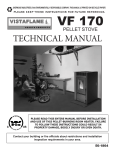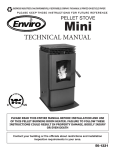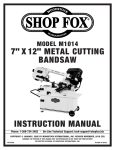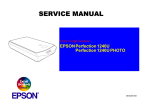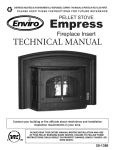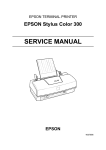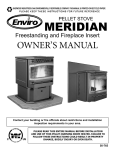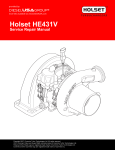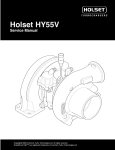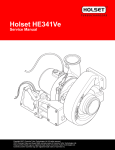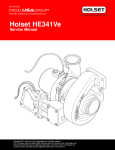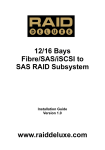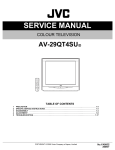Download Epson GT-12000 Service manual
Transcript
GT-1200 EPSON PRODUIT EPSON France S.A. SERVICE MANUAL SERVICE MANUAL Color Image Scanner EPSON GT-12000 ® 4008511 NOTICE n All rights reserved. No part of this manual may be reproduced, stored in a retrieval system, or transmitted in any form or by any means, electronic, mechanical, photocopying, recording, or otherwise, without the prior written permission of SEIKO EPSON CORPORATION. n The contents of this manual are subject to change without notice. n All effort have been made to ensure the accuracy of the contents of this manual. However, should any errors be detected, SEIKO EPSON would greatly appreciate being informed of them. n The above not withstanding SEIKO EPSON CORPORATION can assume no responsibility for any errors in this manual or the consequences thereof. EPSON is a registered trademark of SEIKO EPSON CORPORATION. General Notice: Other product names used herein are for identification purpose only and may be trademarks or registered trademarks of their respective owners. EPSON disclaims any and all rights in those marks. Copyright © 1996 SEIKO EPSON CORPORATION. Printed in Japan. PRECAUTIONS Precautionary notations throughout the text are categorized relative to 1)Personal injury and 2) damage to equipment. DANGER Signals a precaution which, if ignored, could result in serious or fatal personal injury. Great caution should be exercised in performing procedures preceded by DANGER Headings. WARNING Signals a precaution which, if ignored, could result in damage to equipment. The precautionary measures itemized below should always be observed when performing repair/maintenance procedures. DANGER 1. ALWAYS DISCONNECT THE PRODUCT FROM THE POWER SOURCE AND PERIPHERAL DEVICES PERFORMING ANY MAINTENANCE OR REPAIR PROCEDURES. 2. NOWORK SHOULD BE PERFORMED ON THE UNIT BY PERSONS UNFAMILIER WITH BASIC SAFETY MEASURES AS DICTATED FOR ALL ELECTRONICS TECHNICIANS IN THEIR LINE OF WORK. 3. WHEN PERFORMING TESTING AS DICTATED WITHIN THIS MANUAL, DO NOT CONNECT THE UNIT TO A POWER SOURCE UNTIL INSTRUCTED TO DO SO. WHEN THE POWER SUPPLY CABLE MUST BE CONNECTED, USE EXTREME CAUTION IN WORKING ON POWER SUPPLY AND OTHER ELECTRONIC COMPONENTS. WARNING 1. REPAIRS ON EPSON PRODUCT SHOULD BE PERFORMED ONLY BY AN EPSON CERTIFIED REPAIR TECHNICIAN. 2. MAKE CERTAIN THAT THE SOURCE VOLTAGES IS THE SAME AS THE RATED VOLTAGE, LISTED ON THE SERIAL NUMBER/RATING PLATE. IF THE EPSON PRODUCT HAS A PRIMARY AC RATING DIFFERENT FROM AVAILABLE POWER SOURCE, DO NOT CONNECT IT TO THE POWER SOURCE. 3. ALWAYS VERIFY THAT THE EPSON PRODUCT HAS BEEN DISCONNECTED FROM THE POWER SOURCE BEFORE REMOVING OR REPLACING PRINTED CIRCUIT BOARDS AND/OR INDIVIDUAL CHIPS. 4. IN ORDER TO PROTECT SENSITIVE MICROPROCESSORS AND CIRCUITRY, USE STATIC DISCHARGE EQUIPMENT, SUCH AS ANTI-STATIC WRIST STRAPS, WHEN ACCESSING INTERNAL COMPONENTS. 5. REPLACE MALFUNCTIONING COMPONENTS ONLY WITH THOSE COMPONENTS BY THE MANUFACTURE; INTRODUCTION OF SECONDSOURCE ICs OR OTHER NONAPPROVED COMPONENTS MAY DAMAGE THE PRODUCT AND VOID ANY APPLICABLE EPSON WARRANTY. PREFACE This manual describes basic functions, theory of electrical and mechanical operations, maintenance and repair procedures of GT-12000. The instructions and procedures included herein are intended for the experienced repair technicians, and attention should be given to the precautions on the preceding page. The chapters are organized as follows: CHAPTER 1. PRODUCT DESCRIPTIONS Provides a general overview and specifications of the product. CHAPTER 2. OPERATING PRINCIPLES Describes the theory of electrical and mechanical operations of the product. CHAPTER 3. TROUBLESHOOTING Provides the step-by-step procedures for troubleshooting. CHAPTER 4. DISASSEMBLY AND ASSEMBLY Describes the step-by-step procedures for disassembling and assembling the product. CHAPTER 5. ADJUSTMENTS Provides Epson-approved methods for adjustment. CHAPTER 6. MAINTENANCE Provides preventive maintenance procedures and the lists of Epson-approved lubricants and adhesives required for servicing the product. APPENDIX Provides the following additional information for reference: • Connector pin assignments • Electric circuit boards components layout • Exploded diagram • Electrical circuit boards schematics REVISION STATUS Rev. A Date 1997/10/20 Page(s) All Contents First release TABLE OF CONTENTS PRODUCT DESCRIPTIONS 1.1 OVERVIEW....................................................................................................................................................................1-1 1.2 SPECIFICATION ...........................................................................................................................................................1-1 1.3........................................................................................................................................................................................1-4 1.3 INTERFACE SPECIFICATION ......................................................................................................................................1-4 1.4 CONTROL CODE ..........................................................................................................................................................1-5 1.5 OPERATION SPECIFICATIONS ...................................................................................................................................1-6 1.5.1 Switch Specification...........................................................................................................................................................................1-6 1.5.2 LED Specification ...............................................................................................................................................................................1-6 1.5.3 Switch Setting .....................................................................................................................................................................................1-7 1.5.4 Error Indication ...................................................................................................................................................................................1-7 1.5.5 Readable Area.....................................................................................................................................................................................1-8 1.5.6 Transportation Screw.........................................................................................................................................................................1-8 OPERATING PRINCIPLES 2.1 GENERAL DESCRIPTION ............................................................................................................................................2-1 2.2 MECHANISM OPERATING PRINCIPLES.....................................................................................................................2-2 2.3 ELECTRICAL CIRCUIT OPERATIONS.........................................................................................................................2-3 2.3.1 Control Circuit Operation...................................................................................................................................................................2-3 2.3.2 Power Supply Circuit Operation........................................................................................................................................................2-5 TROUBLESHOOTING 3.1 OVERVIEW....................................................................................................................................................................3-1 3.1.1 Error Detection by the Self-Diagnostic Function .............................................................................................................................3-1 3.1.2 Troubleshooting .................................................................................................................................................................................3-2 3.1.2.1 Test Points ................................................................................................................................................................................3-2 3.1.2.2 Check Points for Abnormal Phenomenon .................................................................................................................................3-2 3.1.3 Troubleshooting for Electrical Circuit ..............................................................................................................................................3-8 3.1.3.1 Power Supply Board (B054PSH Board) ....................................................................................................................................3-8 3.1.3.2 Control Circuit Board (B054MAIN Board)..................................................................................................................................3-9 DISASSEMBLY AND ASSEMBLY 4.1 OVERVIEW....................................................................................................................................................................4-1 4.1.1 Tools ....................................................................................................................................................................................................4-1 4.1.2 Screws .................................................................................................................................................................................................4-1 4.2 DISASSEMBLY PROCEDURES ..................................................................................................... ..............................4-2 4.2.1 Electrical Circuit Removal..................................................................................................................................................................4-3 4.2.1.1 EPROM Replacement ...............................................................................................................................................................4-3 4.2.1.2 MAIN/B054PSH Board Removal...............................................................................................................................................4-4 4.2.2 Scanner Body Disassembly...............................................................................................................................................................4-5 4.2.2.1 Upper Housing Removal ...........................................................................................................................................................4-5 4.2.2.2 Scanner Mechanism Removal ..................................................................................................................................................4-6 4.2.3 Scanner Mechanism Disassembly ....................................................................................................................................................4-7 4.2.3.1 Panel Board Assembly Removal...............................................................................................................................................4-7 4.2.3.2 Sub Board Assembly Removal..................................................................................................................................................4-8 4.2.3.3 HP Sensor (CR) Removal .........................................................................................................................................................4-9 4.2.3.4 CR Motor Assembly Removal .................................................................................................................................................4-10 4.2.3.5 Glass Frame Assembly Removal and Pre-operation ..............................................................................................................4-11 4.2.3.6 Lamp Assembly and Inverter Board Assembly Removal ........................................................................................................4-14 4.2.3.7 HP (AF) Sensor Removal........................................................................................................................................................4-16 4.2.3.8 AF Motor Assembly Removal.................................................................................................................................................4-17 4.2.3.9 AF Motor Assembly Installation...............................................................................................................................................4-18 4.2.3.10 Option Frame Assembly Removal.........................................................................................................................................4-19 ADJUSTMENT 5.1 OVERVIEW....................................................................................................................................................................5-1 MAINTENANCE 6.1 OVERVIEW....................................................................................................................................................................6-1 6.1.1 Cleaning...............................................................................................................................................................................................6-1 6.1.2 Lubrication ..........................................................................................................................................................................................6-1 APPENDIX 7.1 OVERVIEW....................................................................................................................................................................7-1 7.1.1 Connector Pin Assignment................................................................................................................................................................7-1 7.1.2 Connector Summary...........................................................................................................................................................................7-1 7.2 COMPONENT LAYOUT ........................................................................................................... .....................................7-6 7.3 CIRCUIT DIAGRAMS ....................................................................................................................................................7-8 7.4 EXPLODED DIAGRAMS .............................................................................................................................................7-10 CHAPTER 1 PRODUCT DESCRIPTIONS GT-12000 Product Descriptions 1.1 OVERVIEW 1.2 SPECIFICATION The GT-12000 is an A3 size flat-bed type color image scanner. The main features of the scanner are: GENERAL Type: Scanning Method: Photoelectric Device: Color Separation: Light Source: Scanning Resolution: Output Resolution: Effective Picture Element: Maximum Readable Area: Scanning Speed: q High resolution Optical resolution is 800 dpi. q Wide readable area Accommodates up to A3 size. q High-quality image 12bit A/D input/output (optical density is 3.0.) q High-speed scanning Scanning A3/Portrate At 800dpi / Draft-mode; Full-color = Approx. 15mS/line 256 Gray = Approx. 10.8mS/line Line art = Approx. 10.8mS/line q Adjustable Focusing function Adjustable up to 5mm above the surface of document table. Flat-bed color image scanner Sub-Scanning mirror movement system Color CCD Line sensor Color filter separation Xe-Gas Cold Cathode Fluorescent Lamp 800 (Main) by 800 (Sub) dpi 50 to 3200dpi (1dpi increment) 9760 by 13760 pixel (Max.) 12.2 by 17.2 inch (310 by 437mm) At 800 dpi / Draft mode; Table 1-1. Scanning Speed Original Reading Area Line Art 256 Gray-scale Full Color A4/Portrait Less than 210mm Approx. 7.5mS/line Approx. 7.5mS/line Approx. 10.0mS/line A4/Portrait - A3/Portrait 210 to 310mm Approx. 10.8mS/line Approx. 10.8mS/line Approx. 15.0mS/line q Quick operation Xe-Gas Cold Cathode Fluorescent Lamp allows no initial light-up for immediate scanning. q New command level: ESC/I-B8 (B6 level with Focus control) q Optional unit enhancing the function of the unit n Transparency Unit n Duplex scanning ADF (Automatic Document Feeder) Rev. A 1-1 GT-12000 IMAGING FUNCTIONS Gradation: Product Descriptions Brightness Control: Input/internal process = Output = 50 to 200% (1% increment) CRT (A/B) PRINTER (A/B/C) User definable (1 level) Impact-Dot Printer Thermal Printer Ink jet Printer CRT Display User definable (1 level) 7 levels Image Processing: Bi-level= Zoom: Gamma Correction: Color Correction: Focusing: INTERFACE Standard Interface: SOFTWARE Commend Level: Rev. A 12bit/pixel 8 or 12bit/pixel Fixed threshold TET Half-toning= Error diffusion (A/B/C) Dither (Resident) (A/B/C/D) Dither (user definable) (A/B) One-piece CCD/Lens movement system Bi-Directional Parallel SCSI (50/50 pin connectors) ESC/I-B8 (B6 level with Focus control) ELECTRICAL SPECIFICATION Power supply voltage: [120 V version] Rated voltage = AC100 - 120 V (± 10%) [220-240 V version] Rated voltage = AC220 - 240 V (± 10%) Rated frequency range: 50 / 60 Hz (49.5 - 60.5 Hz) Power consumption: Approximately 60 W (without an optional unit) Maximum 75 W (with an optional unit) Insulation resistance: 10 M W at 500 VDC (between AC line and chassis) Dielectric strength: AC 1.5 KV / minute (between AC line and chassis) Static electricity: Panel = 10 KV Metal = 7 KV / 150 pF, 150 W SAFETY, EMC Safety regulation: UL1950 with D3 CSA C22.2 NO. 950 with D3 Low voltage directive 73/23/EEC: EN60950 (TUV) EN60950 Nordic Deviation (NEMKO) EMC: FCC Part15 Subpart B Class B (USA) CSA C108.8 Class B (Canada) AS/NZS3548 Class B Directive 89/336/EEC: EN55022 Class B EN61000-3-2 EN61000-3-3 EN50082-1 IEC 801-2 IEC 801-3 IEC 801-4 1-2 GT-12000 Product Descriptions ENVIRONMENTAL CONDITIONS Temperature: Operating = Storage = Humidity: Operating = Storage = RELIABILITY Main unit: 5 to 35°C -25 to 60°C 10 to 80% (no condensation) 10 to 85% (no condensation) PHYSICAL DIMENSIONS AND WEIGHT Dimensions: 656 (W) x 458 (D) x 170 mm (H) (See Figure 1-1.) Weight: Approximately 20 Kg MCBF 100,000 cycle OPERATING CONDITIONS Dust: Ordinary office or home conditions. (Should be kept away from extreme dust.) Illumination: Operation under direct sunlight or near strong light source should be avoided. 170mm (6.7") 458mm (18") DOCUMENT Reflective type: Transparency type: Rev. A 656mm (25.8") Smooth surface such as a printing and photograph. Reversal film, Negative film Note: The optional transparency unit must be used. Figure 1-1. External Dimension of the GT-12000 1-3 GT-12000 Product Descriptions 1.3 INTERFACE SPECIFICATION This scanner is equipped with the following interfaces: q Bi-directional Parallel Interface n Data: 8 bit parallel n Handshake: BUSY, /ACK handshaking n Signal: TTL level n Connector: 36 pins (Amphenol) q SCSI interface n Function: Conforms to ANSI Standard X3.131-1986. n Electrical specification: Conforms to ANSI Standard X3.131-1986. (TTL compatible level) n Connector: 50 / 50 pin (Amphenol) n Terminator: Internal terminator Switches between “active” and “ inactive” n SCSI ID Set with an internal rotary switch (Range: 0 - 7) Rev. A 1-4 GT-12000 Product Descriptions 1.4 CONTROL CODE Table 1-3. Control Code Summary (continued) The command level for this scanner is ESC/I-B8. The commands supported are shown in the table below. Category Auxiliary Table 1-2. Control Code Summary Category Execute Command Data Format Setting Image Setting Image Processing Rev. A Command Name Identity Request Status Flag Request Extended Status Flag Request Parameter Request Scanning Start Set Data Format Set Resolution Set Zooming Set Read Area Set Color Mirroring Set Brightness Set Gamma Correction Download Gamma Table Set Sharpness Set Digital Halftoning Set Auto Area Segmentation Download Dither Pattern Set Color Correction Download Color Correction Set Threshold Code ESC I ESC F ESC f ESC S ESC G ESC Di ESC R n1 n2 ESC H i1 i2 ESC A n1 n2 n3 n4 ESC Ci ESC Ki ESC Li ESC Zi ESC zi d0 d1 - d255 ESC Qi ESC Bi ESC si Control Command Name Set Scanning Mode Initnialize Set Line Counter Control Option Set Focus Focus Position Request Set Ratio Correction for Main and Sub Scan Set the Film type Eject Paper Feed Paper Normal Response Abnormal Response Abort Scanning Header Code ESC gi ESC @ ESC di ESC ei ESC pi ESC q ESC Wi ESC Ni ESC FF ESC PF ACK NACK CAN STX ESC b I I j d (j2) ESC Mi ESC m d1 d2 - d9 ESC t 1-5 GT-12000 Product Descriptions 1.5 OPERATION SPECIFICATIONS 1.5.1 Switch Specification This scanner is equipped with 4 switches. Their functions are described below: q “OPERATE “ n Turns on and off the scanner. n Pressing this switch for power-on initializes the scanner. q “RESET” Initializes the scanner. q SCSI ID rotary switch (located at the back of the scanner) Sets the SCSI device ID for this scanner when the SCSI interface is used to connect the scanner with the host computer. Note: The factory default value for this scanner is “2”. q SCSI terminator setting switch (located at the back of the scanner) Alternates the internal terminator setting between “Connected” and “Disconnected” when the SCSI interface is in use. Note: The factory default setting for this switch is “On” (Connected). ERROR READY OPERATE q OPERATE n Indicates the scanner’s power On/Off status. It is on when the scanner power is on. OPERATE 0 ON 1 2 1.5.2 LED Specification This scanner has the following 3 LED indicators: RESET 3 7 OFF SW 6 5 4 q READY n n Comes on when the scanner is ready to receive commands. It flickers during scanning due to data transmission between the host computer and the scanner. n Indicates an error type in combination with the ERROR LED indicator when an error has occurred. q ERROR n Comes On when an error has occurred. Rev. A Figure 1-2. Buttons, Switches and LED Indicators 1-6 GT-12000 Product Descriptions 1.5.3 Switch Setting 1.5.4 Error Indication Among the switches equipped with this scanner, SCSI switch and the terminator switch, which are used for SCSI interface, have the following settings: q SCSI-ID setting switch ID No. Availability Note 0 Available Normally assigned to other SCSI device such as a hard disc. 1 Available Normally assigned to other SCSI device such as a hard disc. 2 Available Set at the factory to the scanner. 3 Available 4 Available 5 Available 6 Available 7 Available Normally assigned to the SCSI host adopter. (Blank) Not Available Not effective / Not used Not Available Not effective / Not used * When an error has occurred, the error type is indicated by the corresponding combination of the “READY” and “ERROR” LED indicators. üCHECK POINT Table 1-4. Error Types and Corresponding Indications READY n ERROR n Error Type ON ON Command error OFF Blinks Communication error Blinks Blinks Fatal error OFF OFF Option error Note: The remedies for these errors are provided in Chapter 3 “Troubleshooting”. Do not set the ID number that is already assigned to other SCSI device. q Terminator switch Setting Note ON Connects to the terminal resistor. /Factory default setting OFF Disconnects from the terminal resistor. üCHECK POINT Rev. A Be aware that the terminator switch must be set according to the scanner location on the “daisychain”. 1-7 GT-12000 Product Descriptions 1.5.5 Readable Area 1.5.6 Transportation Screw The origin point for this scanner is marked at the rear left corner of the document table viewed from the front. See Figure 1-3 for the maximum readable area of the scanner. A transportation screw is attached to the left side of the scanner viewed from the front. Fastening the screw fixes the CR to protect the scanner from the shock while the scanner is transported or moved. Be sure to turn the screw to the unlocking position (Described in the figure below.) before turning the scanner power on. Main Scan Direction 2 ±1.5mm Sub Scan Direction Origin Point Maximum Readable Area 437mm (17.2") L o c k in g p o s itio n s e t w h ile tr a n s p o r tin g /m o v in g th e s c a n n e r . U n lo c k in g p o s itio n s e t w h ile th e s c a n n e r is u s e d . Front 2 ±1.5mm 2 ±1.5mm 310mm (12.2") 2 ±1.5mm Figure 1-4. Transportation Screw Figure 1-3. Maximum Readable Area Rev. A 1-8 CHAPTER 2 OPERATING PRINCIPLES GT-12000 Operating Principles 2.1 GENERAL DESCRIPTION The EPSON GT-12000 is mainly composed of the following units: q Scanner mechanism (Lamp/Mirror units, CR drive mechanism, integral lens/CCD sensor unit drive mechanism) q Control Circuit q Power supply circuit The EPSON flat-bed type scanners usually read images by moving the integral CR unit which consists of the lamp, mirror, lens/CCD sensor. This scanner, however, characteristically has the CCD sensor and the lens in the whole unit attached onto the mechanism as an independent unit. This scanner is also equipped with the newly designed focusing function which enables the scanner to focus by adjusting the distance between the lens and the CCD sensor. Therefore, the lens unit is set movable and driven by the specified motor. Since the separate units in the mechanism such as the lamp (light source) and the mirrors move at their own speed for reading, the incident distance of the reflected light from the document to the CCD sensor is kept constant. The control circuit board and the power supply circuit board are stored in the separate shield compartment. Since it is only connected to the connector board in the scanner mechanism, it is removed and maintained with ease. B054PNL Board Mirror Unit Lamp/Mirror Unit Motor (for Lens Unit Drive) HP Sensor (for Mirror) Motor (for Lamp/Mirror Drive) Lens Unit Document B054ISN Board (CCD Sensor) Drive Wires HP Sensor (Lens) CN3 CN2 CN1 CN4 CN7 B054SUB Board CN5 B054PSH Board (Power Supply Circuit) B054MAIN Board (Control Circuit) Bi-D I/F SCSI I/F I/F (Optional) CN6 AC Input SCSI ID Switch Terminator Switch Figure 2-1. Main mechanism Structure of the GT-12000 Rev. A 2-1 GT-12000 Operating Principles 2.2 MECHANISM OPERATING PRINCIPLES Compared with other EPSON scanners, the main feature of this scanner lies in its new optical mechanism used for reading images. Instead of the united lamp & CCD movement system used for other scanners, this scanner scans with the fixed CCD sensor and separate lamp and the mirror units. Since the color CCD line sensor is used for the reading device, only one light source is equipped and light is separated through the RGB color filter. As shown in Figure 2-2, the light source (high luminance cold cathode xenon lamp), the first reflection mirror unit and the second reflection mirror unit move independently at their own speed. Therefore the length of the incident light reflected from the document to the CCD sensor is kept constant. (Otherwise, excluding the fixed L1 and L2, LV1 and LV2 keep changing to make the incident light length “L” constant.) Drive from the stepping motor moves each mirror unit via the wires. The CCD sensor and the lens are united into one unit, which is semi-fixed on the base frame. For focusing function, it moves toward the optic with the drive sent from the motor. (The focusing area with this function is from 0 to 5 mm (maximum) above from the glass surface. Rev. A LV1 (Variable) Document L1 (Fixed) Document Glass x1 x2 CCD Sensor Lens Unit Lamp/Mirror unit L2 (Fixed) Mirror Unit LV2 (Variable) Figure 2-2. Optical Unit Structure 2-2 GT-12000 Operating Principles 2.3 ELECTRICAL CIRCUIT OPERATIONS B 0 5 4 IS N B o a r d This section describes the electrical circuit of the GT-12000. D o c u m e n t 2.3.1 Control Circuit Operation R The control circuits of this scanner are: B054MAIN board B054SUB board B054PNL board B054ISN board (Main control circuit board) (Relay board) (Control panel board) (CCD sensor board located on the CR) In v e rte r After passed these processes, image data is finally output to the host. 1 2 b it B 0 5 4 M A IN B o a r d C P U IC 1 3 (H D 6 4 1 3 0 0 3 T F ) Among various functions controlled by B054MAIN board, the core control circuit of the scanner, and B054ISN, process from reading image with the CCD sensor to processing image signals is described below: q B054ISN Board (CCD image sensor) n Photoelectric conversion: Converts light reflected from the document (light energy) into electrical energy (electrical charge). n Amplification n A/D conversion: Converts the image data produced in the form of analog electrical signal into 12-bit digital data. q B054 MAIN Board (processing image data) ASIC (IC24) on this board manages most of the following functions: n Shading correction: Performs image data correction on a black and white basis. n Numbers of image correction such as gamma correction, color correction, halftoning correction. (They are carried out according to the settings on the host side.) B M P X A /D IC 2 (A D 9 8 0 7 ) M o to IC 3 /4 M ir r o L e n s r d r iv e r /5 /6 r S h ift S h ift H P S e n s o r 1 /2 IC 1 E P R O M ( 1 M b it) IC 1 7 P S R A M ( 1 M b it) IC 2 4 (M E R C U R Y ) < Im S G L M C S Z B T A L ig h t Q u a n tity M o n ito r q q q q G C C D a g in g P r o c e s s o r > h a d in g a m m a C o r r e c tio n in e C o r r e c tio n a in /S u b A v e r a g e o lo r C o r r e c tio n m o o th in g o o m i/Q u a d F o r m a ttin g E T A S D R A M (1 M x 4 ) IC 7 /8 /9 < L in e C o r r e c tio n M e m o ry > P S R A M ( 1 M b it) IC 1 8 - 2 3 < R G B Im a g e M e m o ry > D R A M (1 M x 4 ) IC 1 0 /1 1 /1 2 < B u ffe r M e m o ry > C N 6 O p tio n IC 2 8 (G G IF ) < I/F C o n tro l P ro c e s s o r> T P U A D F C N 2 B i- D I/F C N 1 /3 S C S I I/F Figure 2-3. Control Circuit Block Chart Rev. A 2-3 GT-12000 Operating Principles B054MAIN BOARD Name CPU HD6413003TF ASIC MERCURY Location IC13 IC24 ASIC CGIF IC28 DRAM (1MX4) PSRAM (1M) ROM (1M) IC7-9 IC10-12 IC8-23 IC1 Description The CPU, which operates at 16 MHz, controls this board. an image processor which controls the followings: · CCD · Line correction memory · Buffer memory · Image processing This I/F control processor controls the followings: · SCSI I/F · Bi-D I/F · Address decode · PSRAM refresh · Reset control Line correction memory Buffer memory RGB image memory Firmware memory B054SUB BOARD This is a relay board, a module is in the shield compound along with the PSB/PSE board, which connects the B054ISN in the mechanism with the B054PNL board. B054PNL BOARD This board has a power switch (push-lock), RESET switch and LED indicators (OPERATE, READY, ERROR). B054ISN BOARD Name CCD sensor ILX734K Location IC1 ADC AD9807 IC2 Rev. A Description Color CCD line sensor · Effective pixel = 10500x3 lines · Single side reading system · Shutter function A/D converter processing IC Minimum resolution = 12 bit 2-4 GT-12000 Operating Principles 2.3.2 Power Supply Circuit Operation Since the power supply circuit board B054PSH for this scanner meets the universal specification, it can use the rated voltage in the range from 100V to 240V. The electrical circuit for the AC input part is designed on the basis of 200V line. In case the input voltage is 200V line level, the ordinary full wave rectifying system is used. With this system, the voltage is rectified by the diode bridge DB1 and then smoothed by the serial smoothing capacitors C11 and C32 to produce approximately 250 VDC. On the other hand, if the input voltage is 100V line level, the doubled voltage rectifying system is used instead. With this system, the input AC current is separated into the following 2 flows; the positive half cycles of the current flow through the control IC (IC2) (from Pin 2 to Pin 3) via the diode bridge (DB1) and the smoothing capacitor C11, and the negative half cycles of the current, however, flow through the smoothing capacitor (C32) and DB1 via IC2 (from Pin 3 to Pin 2). Through these flows, the positive and negative AC current are separately charged in the smoothing capacitors C11 and C32, respectively, and the doubled VDC (approximately 250 VDC) equivalent to the input voltage of the 200V line is produced. At power-on, the control circuit (IC2) is activated by the full wave rectifying system. Then, if the input voltage is 100 VDC line level, the system is automatically switched to the doubled voltage rectifying system after certain period set by the circuit constant. Except for the full wave rectifier circuit/voltage doubler rectifier circuit at the AC input part, the normal RCC (Ringing Choke Converter) regulator circuit is used for the rest part of the power supply circuit, and the different levels of VDC are distributed to corresponding mechanisms, as shown in Table 2-1: Positive Component DB1 AC input + Negative Component + C11 Doubled Voltage Output C32 IC2 [AC Input] 100 V = On 200 V = Off Figure 2-4. Voltage Doubler Rectifier Circuit Operation Table 2-1. DC Output Power Output VDC +5 V +24 V +15 V Rev. A Application Logic power lines q Motor drive power source q Power source for the lamp (inverter) +12 V production (Power used to drive the cooling fan for the shield compartment which stores B054 MAIN and B054PSH.) 2-5 CHAPTER 3 TROUBLESHOOTING GT-12000 Troubleshooting 3.1 OVERVIEW Fatal Error This chapter describes the troubleshooting which enables you to solve the problem efficiently when the scanner is operating abnormally. The remedies for the errors detected by the self-diagnostic function and the check point for each phenomenon are described in the following sections. 3.1.1 Error Detection by the Self-Diagnostic Function The self-diagnostic function equipped with this scanner automatically detects operating status of each part. The abnormal phenomenon detected by the function and remedies are as follows: LED Status READY ERROR Remedy Cause Operation/Condition <Defect in the hardware> · The lamp goes off · The lamp does not light. and the scanner stops operating. · Scanner is turned on with the CR unlocked. · Sets the status bit “7”. · Other defects in the scanner. Turn the scanner Off and back On or press the “RESET” switch. Command Error LED Status READY ERROR Remedy Cause Undefined command is detected. Operation/Condition Ignores the wrong command /parameter (No change made for the current settings.), and returns NACK to wait for the next command/ parameter. The error is cleared by the correct command/ parameter. Option Error LED Status READY ERROR Remedy Cause <Defect in the options> · The scanner cover is left open. · Paper end, etc.. Operation/Condition Sets the status bit “7”. Remove the cause of the error. Communication Error LED Status READY ERROR Remedy Rev. A Cause Operation/ Condition The lamp goes off and the scanner stops operating. üCHECK POINT [Option Error] is detected when the option is installed in the operative condition only. · Wrong procedure/operation is detected in communication. · In case of SCSI, communication stops for over 30 seconds in any phase other than bus free phase. Turn the scanner Off and back On or press the “RESET” switch. 3-1 GT-12000 Troubleshooting 3.1.2 Troubleshooting 3.1.2.2 Check Points for Abnormal Phenomenon This section provides test points for each major unit and check points for each abnormal phenomenon. See the table below which shows the abnormal phenomenon typically occurs. Table 3-1. Abnormal Phenomenon 3.1.2.1 Test Points Test points for the motors and sensors are shown in the tables below. Abnormal Phenomenon Description 15.0 W The scanner doesn’t operate at power on. “Fatal Error” is indicated and. is not cleared after the scanner is turned off and back on 15.5 W “Communication Error” is indicated. “OPERATE” LED does not light. CR does not move. Abnormal movement of CR, such as crashing into the frame. Lamp does not light. Error when Bi-directional parallel I/F is used. Error when the SCSI is used. Black lines, White banding, and so on Motors q Condition: Test the motor without any cables connected. Motor Test Point <Cable connector> Between Pin 1 and Pin3 Between Pin 2 and Pin 4 <Cable connector> Between Pin 1 and Pin3 Between Pin 2 and Pin 4 Motor (for driving the mirror) Motor (for driving the focusing mechanism) Signal Level Sensors q Condition: Test with the scanner power on. Motor HP sensor (Mirror) HP sensor (Lens/CCD) Test Point <B054SUB board> CN6: Pin 1 (Signal) Pin 2 (GND) <B054SUB board> CN4: Pin 1 (Signal) Pin 2 (GND) Scanned image is abnormal. Signal Level Flowchart to refer 3-1 3-2 3-3 3-4 3-5 3-6 3-7 Check points for the major units listed for each phenomenon are shown in the following pages. H: In the home position L: Off the home position H: In the home position L: Off the home position CAUTION Be careful not to short-circuit the signals while checking them. Rev. A 3-2 GT-12000 Troubleshooting Flowchart 3-1 Phenomenon: “Operate” LED does not light. A Start Are the CN1 on the B054SUB board and the shield compartment connected properly? No Check the following motors for the correct resistance: - Motor (for mirror) : 15.0 Ω - Motor (for focus) : 15.5 Ω Connect them properly. Yes No Has the fuse F1/F2 on the B054PSH board blown out? Yes Are the resistances correct? Disconnect the connector cables from the connectors CN2/4/5/6/7 on the B054SUB board. Yes Check the motor driver ICs on the B054MAIN board. No Disconnect the cables from the connectors CN2/4/5/6/7 on the B054MAIN board, then, with the scanner power on, check the connector CN 5 on the B054MAIN board for the correct voltages shown below: Replace the fuse. Has the fuse blown again at turning on the scanner? <Motor (for mirror) > Check if the resistance between Pin 8/6 of IC4/3 and the GND is infinitive. Replace the B054MAIN board. No <Motor(focus)> Check if the resistance between Pin 1/15 of IC5/6 and the GND is infinitive. Yes Between Pins 1 and 4 : +24VDC Between Pins 7 and 4 : + 5 VDC Between Pins 9 and 10 : +15VDC Replace the B054PSH board. A Replace the motor. Yes Are they correct? Yes Are the outputs all corrects? No No Replace the B054PSH board. Rev. A A Replace the B054MAIN board. 3-3 GT-12000 Troubleshooting Flowchart 3-2 Phenomenon: CR (Mirror/Lamp) does not move. A Start Is the transportation screw set to the locking position? Yes Unlock the screw. Check the following motors for the correct resistance: - Motor (for mirror) : 15.0 W - Motor (for focus) : 15.5 W No Turn th scanner off and move the CR manually to check if it moves smoothly. Does the CR move abnomrmally? No Are the resistances correct? Yes The mechanism is abnormal. (Needs replacing.) Yes Check the motor driver ICs on the B054MAIN board. <Motor (for mirror) > Check if the resistance between Pin 8/6 of IC4/3 and the GND is infinitive. Replace the B054MAIN board. No With the scanner power On, check the connector CN5 on the B054MAIN board for the correct +24 VDC output from the following : <Motor(focus)> Check if the resistance between Pin 1/15 of IC5/6 and the GND is infinitive. Between Pin 1 and Pin 4 : +24 VDC Yes Is the correct voltage output? Rev. A Yes Are they correct? No No Replace the B054PSH board. Replace the motor. A Replace the B054MAIN board. 3-4 GT-12000 Troubleshooting Flowchart 3-3 Phenomenon: CR moves abnormally. (Crashing into the frame) Start Start Is the transportation screw set to the locking position? Flowchart 3-4 Phenomenon: Lamp does not light. Yes Set the screw to the unlocking position. Replace the lamp on the CR. No Does the lamp light normally? Check the connector CN4 on the B054 MAIN board for the HP signal level. Is the signal level "HIGH" when the CR is at the home position? No Replace the HP sensor (for mirror). Yes Lamp is defective. No Replace the inverter board on the CR. Yes Replace the B054MAIN board. Yes Does the lamp light normally? Inverter board is defective. No Replace the B054MAIN board. Rev. A 3-5 GT-12000 Troubleshooting Flowchart 3-5 Phenomenon: “Communication Error”” (Bi-directional I/F) is indicated. Start Flowchart 3-6 Phenomenon: “Communication Error”” (SCSI) is indicated. Start Check the SCSI for the following settings: Replace the interface cable. - Terminator setting - SCSI ID setting Does the scanner operate normally? Yes Replace the I/F cable. No Are the settings correct? No Set them correctly. Yes Repace the B054MAIN board. Replace the I/F cable. Does the scanner operate normally? Yes I/F cable is defective. No Replace the B054MAIN board. Rev. A 3-6 GT-12000 Troubleshooting Flowchart 3-7 Phenomenon: Scanned image is abnormal. Start Is the glass free of stain and foreign matter? No Clean the glass. Yes Is the mirror free of stain and foreign matter? No Clean the mirror. Wipe the mirror with a dry, clean cloth only. Yes Replace the B054MAIN board and perform a test scanning. Yes Is the image normal? B054MAIN board is defective. No The mechnasim is defective. (Needs replacing.) Rev. A 3-7 GT-12000 Troubleshooting 3.1.3 Troubleshooting for Electrical Circuit This section describes the abnormal phenomenon and corresponding check points for each electrical circuit board. 3.1.3.1 Power Supply Board (B054PSH Board) Phenomenon <Abnormal voltage> +5VDC is not output. <Abnormal voltage> +24 VDC is not output. <Abnormal voltage> +15 VDC in not output. Rev. A Check Points Check IC51 (TL494): · Signal waveform output from Pin 8/11 (chopping waveform) Check the Switching FET/Q1: · Waveform at the drain Check IC52 (78M15): · Signal waveform output from Pin 1 3-8 GT-12000 Troubleshooting 3.1.3.2 Control Circuit Board (B054MAIN Board) Phenomenon <No operation at all> Check Points Check the reset IC (IC2) for the signal waveforms output from the following pins: Reset IC is defective. · Pin 7 (for +5V input) · Pin 6 (for PWRES output) <No operation at all> Check the CPU (IC13) for the ROM access signal waveforms output from the following pins: ROM access is bad. · Pin 104 (for CS0 signal) · Pin 78 (for RD signal) <No operation at all> Check the clock signal waveform input to the following pin: CPU is defective. · Pin 75 (for XTAL input) Rev. A 3-9 GT-12000 Troubleshooting Phenomenon <”Fatal Error”> Check Points Check the Driver IC (IC3/4: Motor (for mirror) driver circuit is defective. · Phase drive signal waveform output from Pin 8/6 <”Fatal Error”> Check the driver IC (IC5/6): Motor (for focus) driver circuit is defective. · Phase drive signal waveform output from Pin 1/15 <”Fatal Error”> · Check if the signal waveform input to Pin 91 of CPU (IC13) changes in accordance with the CR position. Check the following for the lamp signal output: CR does not stop at the home position. <”Fatal Error”> Lamp does not light. · Output from Pin 166 of ASIC (IC24) · Emitter waveform at Tr (Q1) <”Fatal Error”> Check ASIC (IC28): White standard level is not read properly. · Signal waveform output from Pin 161 <”Communication Error”> Main cause: ASIC (IC28) is defective. (Replace IC28 or B054MAIN board.) Main cause: ASIC (IC24) is defective. (Replace IC24 or B054MAIN board.) Bi-directional I/F / SCSI I/F <Image is read abnormally> Rev. A 3-10 CHAPTER 4 DISASSEMBLY AND ASSEMBLY GT-12000 Disassembly and Assembly 4.1.2 Screws 4.1 OVERVIEW This chapter describes how to disassemble this scanner. Unless otherwise specified, assembly can be accomplished by following disassembly procedures in reverse order. Screws used in this scanner are listed in the table below. Be sure to use the correct types and numbers of screws for each part when assembling the scanner. Table 4-2. Screw List WARNING n Be sure to disconnect the power cable from the AC power socket prior to servicing. n Since this scanner weighs heavy (approximately 20 Kg), it must be carried by 2 people. CAUTION n Never disassemble any scanner parts unless specified to do so, because this scanner mechanism needs assembling and adjusting rather exactly to preserve accurate control system at its satisfactory level. n Get yourself enough room for servicing, considering the size of the scanner. n Since this scanner weighs as heavy as approximately 20 kg, be sure to perform servicing on a heavy-duty, level table. n Make sure that the “CR fixing knob” is set to the locking position to fix the CR by the rear before packing the scanner. 4.1.1 Tools No. Screw Type / Specification 1 CBP M4x12 Silver 2 CB M4x10 Gold 3 CBS M3x6 Red copper 4 CB M3x4 Gold 5 CBP M3x8 Gold 6 CB M3x6 Gold 7 CB M3x12 Black Tools used for servicing are as listed in the table below: Table 4-1 .Tool List Description Exclusive adjusting tools (Leveling tools) Phillips screw driver (No.2) Standard screw driver (No.1) Tweezers Rev. A Availability SE Part No. EPSON exclusive Code: 1039140 ¡ ¡ ¡ – – – Appearance Color 8 CR;B damper shaft (Thread part: M3x3) Gold 9 CP M3x6 Silver 10 Screw lock screw (Diagonal: 5 mm) Silver 4-1 GT-12000 4.2 DISASSEMBLY PROCEDURES This section describes disassembling and removing procedures for each major unit of the scanner. See the flowchart in Figure 4-1. The jobs in the yellow boxes involve using the adjustment tools exclusively designed for this scanner. Therefore, make sure that you read the instruction for the section to refer to carefully to figure out the procedure before servicing. Disassembly and Assembly Start Electrical Circuit Remova (Section 4.2.1) EPROM Replacement (Section 4.2.1.1) MAIN/Power Supply Board Removal (Section 4.2.1.2) Scanner Body Disassembly (Section 4.2.2) Upper Housing Removal (Section 4.2.2.1) Mechanism Removal (Section 4.2.2.2) Scanner Mechanism Dsassembly (Section 4.2.3) Panel Board Assembly Removal (Section 4.2.3.1) Sub Board Assembly Remvoal (Section 4.2.3.2) HP Sensor (CR) Removal (Section 4.2.3.3) Motor (CR) Assembly Removal (Section 4.2.3.4) Glass Frame Assembly Removal (Section 4.2.3.5) Lamp/Inverter Board Assembly Removal (Section 4.2.3.6) HP Sensor (AF) Removal (Section 4.2.3.7) Option Frame Assembly Removal (Section 4.2.3.9) Figure 4-1. Procedure for Disassembling the GT-12000 Rev. A 4-2 GT-12000 Disassembly and Assembly 4.2.1 Electrical Circuit Removal The major electrical circuit boards (B054MAIN and B054PSH) of this scanner are all stored in one independent shield compartment. Therefore, they can be removed in one unit (board unit) from the scanner with ease. 1. Disconnect the AC power cable from the scanner. 2. Remove 3 screws (No.5) securing the shield compartment which contains the electrical circuit boards at the back of the scanner. Then take out the compartment from the scanner to remove. üCHECK POINT For easy removal, insert a driver or equivalent into the bail lock of the interface and pull it. S c re w (N o .5 ) T a k e o u t Figure 4-2. Shield Compartment Removal 4.2.1.1 EPROM Replacement In case of EPROM replacement, remove the ROM cover attached on the board unit. 1. Remove the board unit. (See Section 4.2.1.) 2. Remove 1 screw (No.3) fixing the ROM cover, and remove the cover. 3. Remove the EPROM from the IC socket and install a new EPROM. Screw (No.3) CAUTION When installing the ROM, make sure that the leads are not bent and the ROM is installed in the right direction. ROM Cover Figure 4-3. ROM Cover Removal Rev. A 4-3 GT-12000 Disassembly and Assembly 4.2.1.2 MAIN/B054PSH Board Removal Connector (CN5) Connector (CN9) B054MAIN and B054PSH boards stored in the shield compartment are removed in the following procedure: 1. Remove the shield compartment. (See Section 4.2.1.) 2. Remove 12 screws (No.3) securing the top shield of the board unit, then remove the top shield. B054MAIN Board 3. [MAIN board assembly removal] Disconnect the connector cables from the connector CN5 and CN9 on the MAIN board. 4. Remove the following screws securing the MAIN board, and remove the MAIN board: Ÿ 6 screws (No.3): Ÿ 6 screws (No. 9): Ÿ 2 screws (No.10): . Fixing the board along the edges. Securing the I/F connector. Securing the optional I/F connector. Screws (No.3) Figure 4-5. MAIN Board Removal 5. [Power supply board assembly removal] Remove the connector cables from the connector CN1 on the power supply board assembly and the connector CN5 on the MAIN board assembly. 6. Remove 6 screws (No.3) securing the power supply board assembly and remove the power supply board. Connector (CN5) B054PSH Board S c re w (N o .9 ) S c re w L o c k S c re w (N o .1 0 ) Figure 4-4. I/F Connector Fixing Screw Removal Screws (No.3) Connector (CN1) Figure 4-6. Power Supply Board Removal Rev. A 4-4 GT-12000 Disassembly and Assembly 4.2.2 Scanner Body Disassembly U s in g th e tw e e z e r s , r e m o v e th e c a p b y liftin g it u p w h ile p u s h in g it to w a r d th e o th e r s id e o f th e c u to u t. This section describes procedures for disassembling the major units of the scanner. C r o s s - s e c tio n CAUTION When removing the CR fixing knob or screw caps, be careful not to damage the upper housing. 4.2.2.1 Upper Housing Removal 1. Remove the document cover. 2. Using tweezers, remove the CR fixing knob attached to the left side of the scanner. 3. Remove 4 screws (2 for each of No1 and No.2) securing the upper housing to the chassises on the scanner. Note that the front 2 screws are covered with the screw caps. Using tweezers, pinch them out prior to removing the screws. 4. Lift up the upper housing to remove it. üCHECK POINT When installing the upper housing, make sure that the optical plate is installed on the specified position. S c re w C a p B e c a re fu l n o t to d a m a g e th e u p p e r h o u s in g . Figure 4-7. Screw Cap Removal S c re w C a p S c re w s (N o .1 ) S c re w s (N o .2 ) S c re w C a p O p tic a l P la te In n e r S id e o f th e U p p e r H o u s in g C R F ix in g K n o b Figure 4-8. Upper Housing Removal Rev. A 4-5 GT-12000 Disassembly and Assembly 4.2.2.2 Scanner Mechanism Removal The scanner mechanism can be removed from the lower housing in the following procedure: Screws (No.1) 1. Remove the upper housing. (See Section 4.2.2.1.) 2. Remove 4 screws (No.1) securing the scanner mechanism to the lower housing at the bottom. Then remove the mechanism from the lower housing. üCHECK POINT n Note the following when installing the scanner mechanism: 1) Remove the key tops for the power switch and reset switches from the lower housing. 2) Install the scanner mechanism to the lower housing. 3) Reinstall the key tops. n Place the removed mechanism on flat stable surface. Scanner Mechanism Front Side of the Scanner Figure 4-9. Scanner Mechanism Removal Rev. A 4-6 GT-12000 Disassembly and Assembly 4.2.3 Scanner Mechanism Disassembly The rest part of the chapter describes the procedures for removing the major parts/units in the scanner mechanism. CAUTION Note that producing this scanner requires rather precise assembly and adjustment to ensure accurate control system. Therefore, never disassemble any scanner parts unless specified to do so. Panel Board Assembly 4.2.3.1 Panel Board Assembly Removal 1. 2. 3. 4. Remove the scanner mechanism. (See Section 4.2.2.2.) Turn the mechanism over and place it on a flat surface. Disconnect all connector cables from the panel board assembly. Remove 2 screws (No.6) securing the panel board assembly and remove it. üCHECK POINT Unit arrangement at the bottom of the mechanism is as shown below. Motor (CR) HP Sensor (CR) HP Sensor (AF) Rev. A Screws (No.6) Figure 4-10. Panel Board Assembly Removal Panel Board Assembly Sub Board Assembly 4-7 GT-12000 Disassembly and Assembly 4.2.3.2 Sub Board Assembly Removal 1. Remove the scanner mechanism. (See Section 4.2.2.2.) 2. Turn the mechanism over and place it on a flat surface. 3. Disconnect all connector cables from the sub board assembly (B054SUB board). 4. Remove 2 screws (No.3) securing the board to the bracket and remove the sub board. üCHECK POINT Sub Board Assembly When placing the scanner up side down, lay a clean soft cloth under the scanner to protect the glass surface. Screws (No.6) Figure 4-11. Sub Board Assembly Removal Rev. A 4-8 GT-12000 Disassembly and Assembly 4.2.3.3 HP Sensor (CR) Removal This section describes procedure for removing the HP sensor which detects the reference position for the carriage mirror assembly. 1. 2. 3. 4. Motor (CR) HP Sensor (CR) Panel Board Assembly Remove the scanner mechanism. (See Section 4.2.2.2.) Move the carriage mirror assembly away from the HP (home position). Turn the mechanism over and place it on a flat surface. Release the hook fixing the HP sensor at the bottom of the mechanism and remove the HP sensor unit. Then disconnect the connector cable from the removed HP sensor. HP Sensor (AF) Sub Board Assembly Figure 4-12. HP Sensor (CR) Removal Rev. A 4-9 GT-12000 Disassembly and Assembly 4.2.3.4 CR Motor Assembly Removal This section describes procedure for removing the motor unit which drives the carriage mechanism (mirror/lamp). 1. Remove the scanner mechanism. (See Section 4.2.2.2.) 2. Turn the mechanism over and place it on a flat surface. 3. Unhook the torsion spring from the tension lever assembly, then remove 1 screw (No.6) to remove the tension lever assembly. 4. Disconnect the cable for the motor from the relay connector and remove 4 CR damper shafts; B (No.8) securing the motor, then remove the motor. üCHECK POINT Bottom of the Scanner Facing Upward Tension Lever Assembly Motor (CR) Assembly When assembling, hook the spring to the tension lever assembly first, then fasten the screw. Torsion Spring CR Damper Shafts ;B (No.8) Screw (No.6) Figure 4-13. CR Motor Assembly Removal Rev. A 4-10 GT-12000 Disassembly and Assembly 4.2.3.5 Glass Frame Assembly Removal and Pre-operation Since the glass frame assembly is one of the reinforcing parts of the mechanism, whole mechanism may be deformed if it is removed. Be sure to follow the instruction provided in this section during any service which involves removing the glass frame assembly. T u r n in g T a b le ( w ith 4 d e v is io n s ) CAUTION Be aware the following when removing the document glass during any service: n Always set the scanner on the adjusting tools exclusively designed for this scanner. n Set the scanner on a stable, level table. n Make sure that the scanner mechanism is installed to the lower housing while servicing. n Be sure to fit all the rubber foot at the bottom of the scanner in the top indents of the stages and the adjuster. (Any of the foot must not be placed over the top surface of the tool.) 1. Remove the upper housing. (See Section 4.2.2.1.) 2. Refer to the figures in the right column and set the adjusting tools (leveling tools) under the scanner to level the scanner, as instructed below: 1) Set the scanner on 3 stages, making each of the specified feet of the scanner sit on the corresponding stage. 2) Set the adjuster under the rubber foot in the front right corner of the scanner bottom, aligning the center of the adjuster with the one of the rubber foot. Make sure that you can see the groove on the adjuster when it is set. 3) Hold the base of the adjuster with a hand and spin the table to make it reach the bottom of the scanner by its own forth. 4) Turn the table [2 quarters] manually, which can be measured by 4 divisions on the table and the groove on the base, to push the table up from the position where the table was moved up to by the spin. 5) After adjusting, make sure that each corner of the scanner is securely in contact with the corresponding tool. Note: Directions are described when the scanner is viewed from the front. B a s e ( w it h 1 g r o o v e ) S ta g e ( 3 p ie c e s ) A d ju s te r Figure 4-14. Adjusting Tools S ta g e ( S e t in th e fr o n t le ft, r e a r r ig h t a n d r e a r le ft c o n e r s .) A d ju s te r ( S e t in th e fr o n t r ig h t c o n e r .) T u to a n h e rn m o d d ig h th e tu r n in g ta b le v e th e ta b le u p o w n to a d ju s t t. Figure 4-15. Tool Position and Adjusting Method <Continued to the next page.> Rev. A 4-11 GT-12000 Disassembly and Assembly 3. Remove 9 screws and remove the glass frame assembly. The screws to be removed and their locations are as follows: · No.4: 5 screws securing the glass frame assembly by the right and left sides. · No.1: 2 screws securing the glass frame assembly by the rear edge. · No.3: 2 screws securing the glass frame assembly by the front edge. Note: Directions are described when the scanner is viewed from the front. Glass Fixing Plate (Color : Silve) Screws (No.1) Screws (No.4) Screws (No.4) CAUTION When reinstalling the glass frame assembly, refer to Section 4.2.3.5.1 to set the glass frame assembly on the correct position. Failure in this operation will cause the CR to start scanning at a wrong position. Glass Frame Assembly Screws (No.3) Glass Fixing Plate (Color : Silve) Front Side of the Scanner Figure 4-16. Glass Frame Assembly Removal Rev. A 4-12 GT-12000 Disassembly and Assembly 4.2.3.5.1 Glass Frame Assembly Installation After the glass frame assembly has been removed for any purpose, it must be reinstalled in the following procedure. 1. Place the glass frame assembly to the specified position in the scanner mechanism. 2. Referring to the Figure 4-17, determine the installation position for the glass frame assembly. G la s s e d g e P o s itio n in g B u s h ( C o lo r : S ilv e r ) F r a m e P o s itio n in g B u m p 1) Push the whole glass frame assembly from the front against the positioning bushes (color: silver) on the top side of the rear frame. (Glass edge is in contact with the bushes with this operation.) 2) Keeping the glass frame assembly in contact with the bushes, move the assembly left to push it against the positioning bump on the top surface of the left side frame. 3. When the glass frame assembly is correctly positioned, fix it with 9 screws. üCHECK POINT When installing the glass frame assembly, ensure that 4 glass fixing plates are properly positioned. (See Figure 4-16.) G la s s F r a m e A s s e m b ly S c a n n e r F r o n t S id e Figure 4-17. Determining the Glass Frame Assembling Installation position Rev. A 4-13 GT-12000 Disassembly and Assembly 4.2.3.6 Lamp Assembly and Inverter Board Assembly Removal This section describes how to remove the lamp assembly and the inverter board assembly from the carriage. <Continued to the following page.> CR Mirror Cover 1. Remove the glass frame assembly. (See Section 4.2.3.5.) 2. Move the CR to the position indicated in Figure 4-19. (The position where the front and rear frames are indented.) 3. Remove 2 screws (No.6) securing the carriage mirror cover and slide the cover toward the rear side of the scanner to release the engagement with the hook on the carriage. Then lift up the cover and remove it. Screws (No.6) Figure 4-18. CR Mirror Cover Removal Rev. A 4-14 GT-12000 Disassembly and Assembly 4. Disconnect the connector cable for the lamp from the connector CN2 on the inverter board assembly. Then remove the lamp from the carriage. 5. Disconnect the cable (black) from the connector CN1 on the inverter board assembly. Then remove the bracket (silver) fixing the ferrite core. 6. Remove 2 screws (No.6) securing the inverter board assembly. 7. Slide the inverter board assembly toward the front side of the scanner to release the engagement with the hook on the carriage. Then remove the inverter board. üCHECK POINT Lift up to remove. CN2 When assembling, make sure that the cover is securely engaged with the hook on the carriage. C o v e r R e a r C a r r ia g e B a s e F ro n t Inverter Board Lamp H o o k Cut Part of the Board CN1 Screws (No.6) Figure 4-19. Lamp Assembly and Inverter Board Assembly Removal Rev. A 4-15 GT-12000 Disassembly and Assembly 4.2.3.7 HP (AF) Sensor Removal This section describes the procedure for removing the HP sensor which detects the reference position for the AF drive mechanism (lens/CCD sensor unit). 1. Remove the glass frame assembly. (See Section 4.2.3.5.) 2. Remove 4 screws (No.3) securing the AF drive mechanism cover which covers the AF drive mechanism and remove the cover. 3. Rotate the screw pulley at the end of the screw shaft (a thread shaft) manually to move the detection flag to the area where it does not overlap with the HP sensor. 4. Release the hook fixing the HP sensor and remove it, then disconnect the cable from the sensor. Rotate this pulley manually. HP Sensor (AF) Screws (No.3) Cover Detection Flag Figure 4-21. HP Sensor (AF) Removal Figure 4-20. AF Drive Mechanism Cover Removal Rev. A 4-16 GT-12000 Disassembly and Assembly 4.2.3.8 AF Motor Assembly Removal Screws (No.4) This section describes how to remove the motor which drives AF drive mechanism. 1. Remove the glass frame assembly. (See Section 4.2.3.5.) 2. Remove 4 screws (No.3) and remove the cover which covers the AF drive mechanism. 3. Remove 2 screws (No.6) and remove the tension plate assembly, spring plate and fixing tension plate to loosen the timing belt. 4. Disconnect the cable for the motor from the relay connector, then remove 4 screws (No.4) securing the motor and remove the motor. Screws (No.6) Tension Plate Assembly Fixing Tension Plate Motor Assembly (AF) Figure 4-23. AF Motor Assembly Removal CAUTION You are required to set the timing belt with a Spring Plate special care while installing the AF motor assembly. Be sure to follow the instruction provided in the next page to set the timing belt peoperly. Figure 4-22. Tension Plate Assembly Removal Rev. A 4-17 GT-12000 Disassembly and Assembly 4.2.3.9 AF Motor Assembly Installation Follow the steps below when installing the AF motor assembly to the scanner body. üCHECK POINT When installing the tension plate assembly, make sure that the location bump is not covered with the plate. 1. Engaging the timing belt with the pinion gear of the motor, install the motor to the frame with 2 screws (No. 4). 2. Mount the sprint plate, fixing tension plate, and the tension plate assembly, and fix them with 2 screws (No. 6) temporarily. Ensure that the tension plate assembly is upheld by this operation. 3. Turning the screw pulley attached to the screw shaft end manually, loosen the screw fixing the tension plate assembly to tense the belt, then fasten the screw again. T e n s io n P la te A s s e m b ly CAUTION When fixing the tension plate assembly, be careful not to apply excessive tension, since it may cause the motor to rotate improperly. S c re w s (N o . 6 ) F ix in g T e n s io n P la te S p r in g P la te S c r e w P u lle y ( r o ta te d c o u n te r c lo c k w is e ) Figure 4-25. Timing Belt Tension T e n s io n P la te A s s e m b ly Figure 4-24. Tension Plate Assembly Rev. A 4-18 CHAPTER 5 ADJUSTMENT GT-12000 Adjustment 5.1 OVERVIEW This scanner requires no adjustment for any service such as disassembling and assembling the scanner including part replacement is provided within the specification in Chapter 4 “Disassemble and Assembly”. Rev. A 5-1 CHAPTER 6 MAINTENANCE GT-12000 Maintenance 6.1 OVERVIEW This chapter provides information necessary to keep the scanner function in optimum condition constantly and to prevent troubles. 6.1.2 Lubrication This scanner needs no lubrication at the level of service specified in the service manual. 6.1.1 Cleaning Perform cleaning when stain is noticeable. Stain on the document glass, particularly, has direct effect on scanned image. Therefore, be sure to clean the glass well to remove stain thoroughly. CAUTION Never apply any organic solvent such as thinner and benzine , since these may deteriorate plastic and rubber parts. q Outer cases Wipe stain off with a clean cloth which is moistened with water and then squeezed tightly. To remove severe stain, use neutral detergent. q Document glass Remove dust and paper debris with a dry clean cloth. If stain is severe or foreign matter is stuck, use a cloth absorbed with neutral detergent. If trace is left, wipe it off well with a dry, clean cloth again. CAUTION If you need to clean the reverse side of the glass, be sure to remove the glass using the specified adjusting tools. Rev. A 6-1 CHAPTER 7 APPENDIX GT-12000 Appendix 7.1 OVERVIEW 7.1.2 Connector Summary This chapter provides information necessary for servicing. Connectors used on the electrical circuit boards are summarized in the table below. 7.1.1 Connector Pin Assignment Table 7-1. Connector Summary S c a n n e r M e c h a n is m B 0 5 4 P N L B o a r





























































































































































